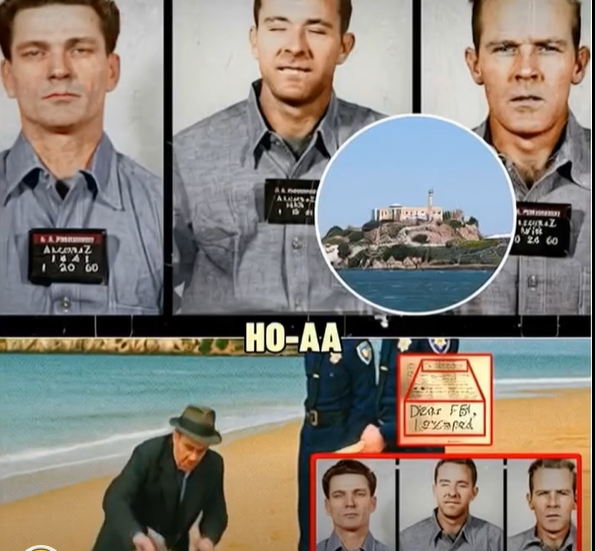It was a cold, moonless night in June 1962 when three prisoners at America’s most infamous prison vanished into the darkness. Their disappearance would spark one of the greatest mysteries in U.S. history, fuel decades of speculation, and inspire countless books, documentaries, and Hollywood films. For more than half a century, the fate of the Alcatraz escapees remained a riddle. But in recent years, stunning breakthroughs have begun to shed new light on what really happened that night.
What investigators have uncovered is not only fascinating—it challenges everything once believed about “The Rock” and its reputation as an inescapable fortress.
The Legend of Alcatraz
Alcatraz Island, a rocky outcrop in the middle of San Francisco Bay, is surrounded by freezing waters, swift tides, and dense fog. From the moment it opened as a federal penitentiary in 1934, it was branded “escape-proof.”
The prison was designed to hold the most dangerous and notorious criminals of its time, men who had slipped through the cracks of other institutions. Some of its infamous residents included Al Capone, George “Machine Gun” Kelly, and Robert Stroud, better known as the “Birdman of Alcatraz.”
But it wasn’t just the steel bars and armed guards that made the prison intimidating. The true deterrent was the environment itself: bone-chilling water temperatures that hovered around 50 to 55 degrees Fahrenheit, strong ocean currents capable of sweeping away even the strongest swimmers, and jagged rocks that lined the shoreline. Escape wasn’t just difficult—it seemed suicidal.
Over the course of its 29 years as a federal prison, 36 men tried to escape in 14 separate attempts. Most were quickly captured, six were shot dead during their flight, and at least two were confirmed drowned. The rest disappeared without a trace. Yet no case became more legendary than the 1962 escape led by Frank Morris and the Anglin brothers.
The Masterminds Behind the Plan
Frank Morris, known for his sharp intelligence and history of prison breaks, arrived at Alcatraz in 1960. Around the same time, brothers John and Clarence Anglin—both skilled swimmers from Georgia who grew up working construction and robbing banks—were also transferred to the island.
Together, they formed an unlikely alliance. With the help of another inmate, Allen West, they began plotting an escape that would go down in history.
For months, the men worked in secret. Using crude tools fashioned from spoons, broken saw blades, and even a stolen motor from a prison vacuum cleaner, they chipped away at the ventilation ducts in their cells. To mask the noise, they timed their work with the prison’s loud music hour.
But the men didn’t stop there. They created lifelike decoys out of soap, toilet paper, and hair stolen from the prison barbershop. These dummy heads were placed in their bunks during night checks, ensuring guards saw “sleeping inmates” while the real men slipped away.
Perhaps their most ingenious creation was the raft and life vests. Using more than 50 stolen raincoats, they stitched together a makeshift inflatable craft, sealing the seams with heat from steam pipes.
The Night of the Escape
On June 11, 1962, the plan was set in motion. As the rest of the prison slept, Morris and the Anglin brothers crawled through the ventilation holes they had widened, maneuvered through a network of utility corridors, and climbed to the roof.
Allen West, however, never made it out. His hole was not big enough, and he was forced to abandon the escape.
The others shimmied down pipes, crossed the yard, and reached the shoreline. There, they inflated their raincoat raft, pushed into the frigid waters, and paddled into the darkness.
By morning, chaos erupted inside the prison. Guards discovered the lifelike dummy heads, but the real inmates were gone. A search of the island turned up a paddle, pieces of raincoats, and later, on Angel Island two miles away, a homemade raft and some personal belongings.
The official conclusion: the men drowned. But with no bodies recovered, doubt lingered.
The FBI Manhunt
The escape triggered one of the largest manhunts in American history. Helicopters scanned the bay, boats patrolled the waters, and law enforcement combed the coastline.
Wanted posters featuring the faces of Morris and the Anglins were plastered across the country. The FBI closely monitored their families, hoping for contact. Yet years passed without any conclusive evidence.
In 1979, after 17 years of chasing leads, the FBI officially closed its investigation. The escapees were presumed dead. But the legend only grew stronger.
Rumors, Sightings, and Conspiracy Theories
Despite the official stance, speculation ran wild. Some investigators believed the men had criminal connections who could have arranged for a boat pickup that night. Others pointed to the Anglins’ swimming abilities, noting they had once practiced in icy waters back in their youth.
Over the decades, alleged sightings of the escapees popped up worldwide—Brazil, Mexico, and even the American Midwest. Families of the Anglin brothers claimed to have received unsigned postcards and mysterious phone calls over the years. Photographs surfaced showing men who bore striking resemblances to John and Clarence.
In 2003, the popular show MythBusters recreated the escape using the same type of raft made from raincoats. The team successfully made it to Angel Island, proving that survival was possible.
Still, without hard proof, the mystery endured.
The Letter That Reopened the Case
In 2013, the story took a dramatic turn. The San Francisco Police Department received a handwritten letter, allegedly from John Anglin.
In the letter, the writer claimed that he, Clarence, and Morris had all survived the 1962 escape. He said they had lived in hiding for decades and were now elderly men. Claiming to be suffering from cancer, the writer offered to turn himself in if he could receive proper medical treatment.
Authorities tested the letter for fingerprints and DNA, and handwriting experts analyzed the script. The results were inconclusive—neither confirmed nor disproved the claim.
Was this the long-awaited confession, or just an elaborate hoax? The public remained divided.
The Brazilian Photograph and AI Breakthrough
Then, in 2018, new evidence reignited the debate: a photograph allegedly taken in Brazil in 1975. It showed two men standing on a farm, bearing a striking resemblance to the Anglin brothers.
For years, the photo was dismissed as too grainy to be reliable. But advances in artificial intelligence changed that.
Rothco, an Irish creative agency, partnered with Ident TV, a U.S. AI company specializing in facial recognition. They used state-of-the-art software to analyze the photograph, comparing facial structures to known images of John and Clarence Anglin. The results were compelling—the likelihood that the men were indeed the Anglins was deemed high.
While not definitive proof, the findings gave new weight to the possibility that the escapees had not only survived but also successfully built new lives far from American authorities.
The Enduring Mystery of Alcatraz
Today, more than 60 years after the daring escape, the fate of Frank Morris and the Anglin brothers remains uncertain. Officially, the U.S. Marshals Service still lists the men as fugitives, keeping the case technically open until their 100th birthdays.
For many, the story symbolizes both the ingenuity of the human spirit and the enduring allure of mystery. Did the men beat the odds and outwit the “inescapable” prison, or did they meet their end in the freezing waters of San Francisco Bay?
What is certain is that their story continues to capture the imagination of people around the world. From classrooms to TV specials, from researchers to conspiracy theorists, the great Alcatraz escape endures as one of the most fascinating unsolved puzzles in American history.
Conclusion
The escape from Alcatraz is more than just a prison break—it is a tale of resilience, ingenuity, and enduring mystery. Despite decades of investigation, the question remains: did Morris and the Anglin brothers die in the bay, or did they truly pull off the impossible?
Thanks to modern technology and persistent curiosity, we may be closer than ever to finding out. Until then, the legend lives on, reminding us that some mysteries refuse to be locked away.




